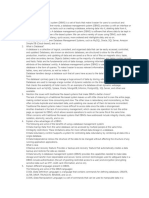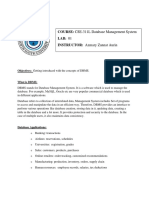0% found this document useful (0 votes)
8 views3 pagesDBMS Topics Detailed Explanation
The document provides a comprehensive overview of Database Management Systems (DBMS), covering key concepts such as data, databases, and the functionalities of DBMS. It discusses advantages, types, architecture, and users of DBMS, as well as important topics like the relational model, normalization, SQL basics, and transactions. Additionally, it touches on indexing, query optimization, distributed DBMS, NoSQL, and security measures.
Uploaded by
73SAUMYA SINHACopyright
© © All Rights Reserved
We take content rights seriously. If you suspect this is your content, claim it here.
Available Formats
Download as PDF, TXT or read online on Scribd
0% found this document useful (0 votes)
8 views3 pagesDBMS Topics Detailed Explanation
The document provides a comprehensive overview of Database Management Systems (DBMS), covering key concepts such as data, databases, and the functionalities of DBMS. It discusses advantages, types, architecture, and users of DBMS, as well as important topics like the relational model, normalization, SQL basics, and transactions. Additionally, it touches on indexing, query optimization, distributed DBMS, NoSQL, and security measures.
Uploaded by
73SAUMYA SINHACopyright
© © All Rights Reserved
We take content rights seriously. If you suspect this is your content, claim it here.
Available Formats
Download as PDF, TXT or read online on Scribd
/ 3


























































